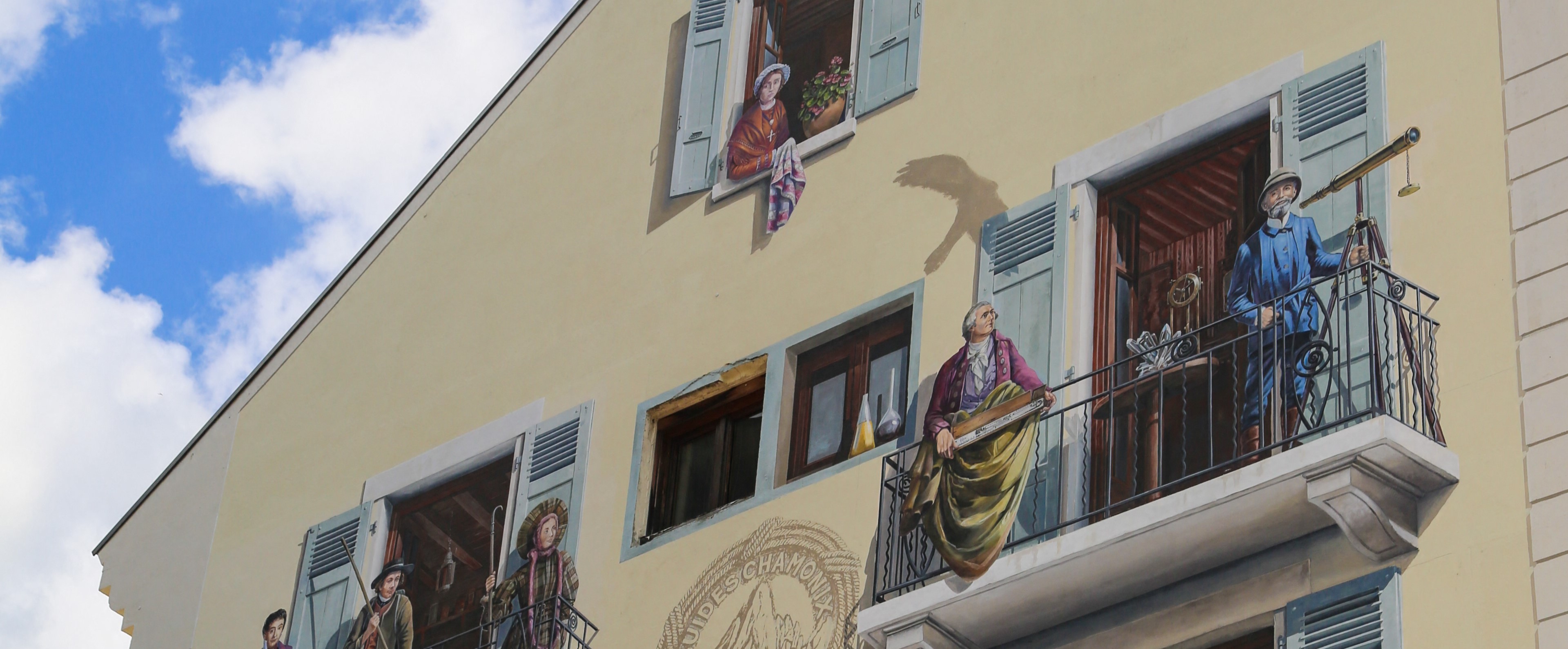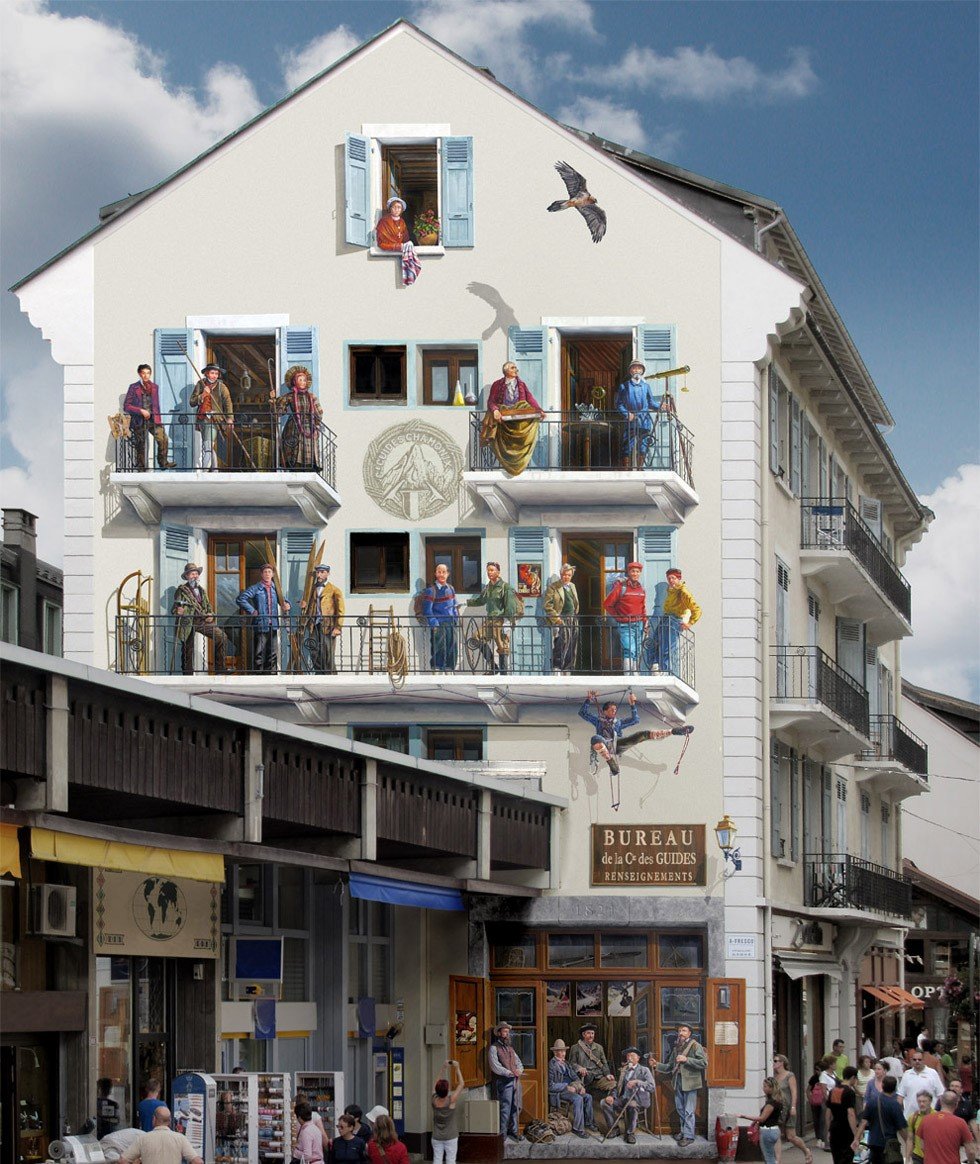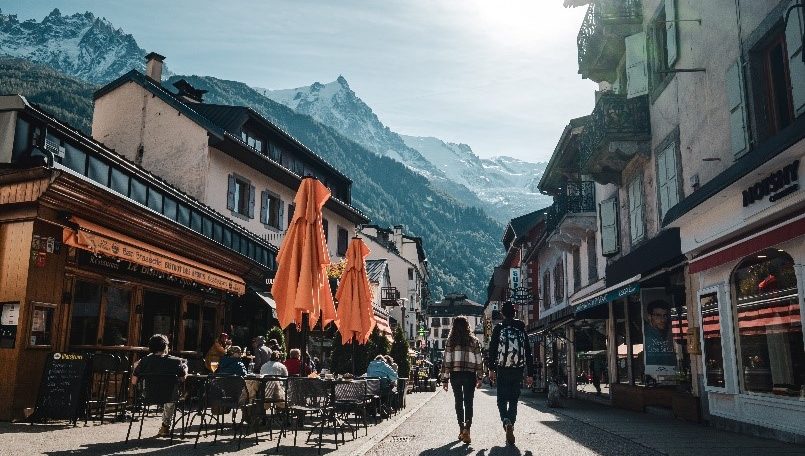Taking a walk through Chamonix town centre, just across the road from Lou Lou Apartment. you will surely notice an impressive mural on the main street, Rue du Docteur Paccard. Looking up towards their shared fascination, Mont Blanc; twenty of the most celebrated guides and mountaineers are represented in extraordinary precision in the best of Chamonix’s Murals.
The Mountain Guides Fresco
The painting of this Chamonix mural is by award winning Patrick Commecy – founder, manager and artistic director of A.Fresco which since 2002 has produced over 150 frescoes in France, Italy and Switzerland. The Mountain Guides Fresco was financed by the town’s Mayor and was inaugurated in July 2010.
For the first time the legendary greats of Chamonix – the pinnacle of the mountaineering community in Europe – are gathered in a single image.
We thought you might like to know who they are and why they’re up there. So here’s an historical round-up of the fresco’s collected members of the Compagnie des Guides de Chamonix. They range from Michel-Gabriel Paccard and Jacques Balmat, the first to climb Mont Blanc in 1786 (the two leftmost figures on the top left balcony), to Gaston Rebuffat – a local filmmaker and writer, who was first to summit Annapurna 1 in 1950 (dangling in his harness) and Maris Paradis, the inn attendant who, aged 29, became the first woman to summit Mont Blanc (top window).
Chamonix’s Historic Guides
Ground Floor (guides office):
From L: Edouard Cupelin (Guide, 1804-1906), his 80 climbs to the summit earned him the nickname “Captain of Mont Blanc”. He achieved several firsts in Switzerland and on the Mont Blanc massif including the first winter ascent of the Aiguille du Midi in 1883 with his client English Mrs Burnaby.
Francois Devouassoud, (Teacher, 1832-1905), major exporter of mountaineering. In 1868 he made the first ascents of Kazbek and the east summit of Elbrus (5,593m) in the Caucasus among more than 50 other firsts in the world.
Joseph Ravanel, (Guide, 1869-1931), nicknamed “the Red”, and called the “guide of Kings and King of guides”. Alongside Émile Fontaine, Joseph Ravanel guided King Albert 1st of Belgium, the painter Edgard Bouillette and photographer Gaston Liégeard. He appears, renamed “Joseph Ravanat”, in the novel “Premier de cordée” by Roger Frison-Roche.
Michel Payot (Guide and farrier, 1840-1922), achieved many firsts, and is considered to be the successor of Michel Croz. In 1877 he succeeded in the first ascent of the southern slope of Mont Blanc, via the Peuterey ridge, an ascent not repeated until 1919.
Michel Croz, (Guide, 1830-1865). As well as making the first ascent of some of the most significant unclimbed mountains in the Alps – the Grande Casse, Monte Viso, the Barre des Écrins and the Aiguille d’Argentière – he also made the first traverse of many previously uncrossed cols. He is chiefly remembered for his death on the first ascent of the Matterhorn and for his climbing partnership (as a guide) with Edward Whymper.
Dangling:
Gaston Rebuffat: (Filmmaker, writer, 1921-1985) Well known as a member of the first expedition to summit Annapurna 1 in 1950 and the first man to climb all six of the great north faces of the Alps. Authored 10 books and produced 3 films documenting his climbing experiences.
1st Floor Balcony:
Left side, from L: Jean-Esteril Charlet Straton. (Guide, 1840-1925). First shepherd, then carpenter, then porter, then guide. He made many firsts with his partner, later wife, Isabelle, including Pointe Isabelle in 1875 (3,761m), and the first winter ascent of Mont Blanc in 1876. He also famously made the first ascent of the Petit Dru in 1879.
Alfred Couttet, (Guide, 1889-1974). 1st French ski champion in 1909, French ski captain at the 1924 Olympic Games. Achieved 40 firsts on different mountain ranges from Tatras, Sierra Nevada & the Dolomites. In the Dolomites, he discovered the use of pitons, carabiners and climbing shoes. It was at his instigation that Simond made the first french pitons in Chamonix. He cleared the cliffs at Les Gaillands and founded a climbing school with Roger Frisson-Roche.
Michel Payot. (Doctor, 1869-1908). The first to use skis in the valley to visit his patients in isolated villages. He made many firsts on skis, including the Chamonix – Zermatt crossing in 1903. An initiator of mountain skiing, he organized the 1st international Chamonix ski competition in 1908.
Right side balcony, from L: Louis Lachenal (Guide, 1921-1955). One of the first two mountaineers to climb a summit of more than 8,000 meters. On 3 June 1950 on the 1950 French Annapurna expedition, along with Maurice Herzog, he reached the summit of Annapurna I (8,091 m). Died falling into a snow-covered crevasse while skiing the Vallee Blanche in Chamonix. The mountain Pointe Lachenal in the Mont Blanc massif was named after him.
Lionel Terray, (Guide, 1921-1965), many firsts in the Alps and on all continents, author in 1950 of the cult novel “The Conquerors of the useless”. Terray, frequently with climbing partner Louis Lachenal, broke previous climbing speed records. A member of Maurice Herzog’s 1950 expedition to the Nepalese Himalayan peak, Annapurna, the highest peak climbed at the time, and the first 8000-meter peak climbed.
Roger Frison-Roche,(Guide, explorer, writer, 1906-1999), creator of the Les Gaillands climbing school, author of the famous novel “Premier de cordée” (or “First on the Rope”). In 1924 , he was the secretary of the first Winter Olympic Games in Chamonix. In 1928, he made the first winter of the Bionnassay needle with Armand Charlet. 1930 became the first non-chamoniard to be admitted into the Compagnie des Guides de Chamonix.
Rene Claret-Tournier, (Guide, 1917 – 2013) 530 climbs of Mont Blanc, following in footsteps of his ancestor Michel-Gabriel Paccard who was the first to summit Mont Blanc. A guide who served in the mountain artillery in WW2, Tournier was captured and remained a prisoner of war until liberation in 1945. He learnt German and used it in the post war years to guide clients like Joseph Klaus, the chancellor of Austria.
Armand Charlet. (Guide, 1900-1975), specialist in difficult climbs, he climbed the Aiguille Verte more than 100 times, calling it “his” mountain.
2nd Floor Balconies
Left: Michel-Gabriel Paccard (Doctor, 1757-1827) and Jacques Balmat (Cristallier, 1762-1834), the first men at the top of Mont Blanc, August 8, 1786. Their ascent of Mont Blanc was a major accomplishment in the early history of mountaineering. C. Douglas Milner wrote “The ascent itself was magnificent; an amazing feat of endurance and sustained courage, carried through by these two men only, unroped and without ice axes, heavily burdened with scientific equipment and with long iron-pointed batons. The fortunate weather and a moon alone ensured their return alive.”
Henriette d’Angeville (Mountaineer, 1794-1871), second woman at the summit, in 1838. Reached the summit in the company of, but without physical assistance from, twelve guides and porters. At the age of forty-four she became the second woman to climb Mont Blanc, thirty years after Marie Paradis (1778 – 1839). Read more about the women of mountaineering.
Right: Horace-Benedict de Saussure (Physicist, 1740-1799), 3rd ascent on Mont Blanc with Jacques Balmat on August 2, 1787. Genevan geologist, meteorologist, physicist, mountaineer and Alpine explorer, often called the founder of alpinism and modern meteorology, and considered to be the first person to build a successful solar oven.
Joseph Vallot (Astronomer and Geographer, 1854-1925), created the Vallot observatory, at the foot of the Bosses ridge, from 1890 and 1898 and made 34 climbs to the summit of Mont Blanc. He used the observatory-laboratory to engage in many scientific experiments, at a time when doctors considered it very dangerous for health to fall asleep at such a high altitude, some even predicting death.
3rd Floor Window
Marie Paradis (inn attendant, 1779-1839), first woman at the top of Mont Blanc, led by Jacques Balmat, July 14, 1808. Paradis was a poor maidservant who lived in Chamonix. The party camped on the Grands Mulets, and during the final ascent Paradis became fatigued and was assisted by her guides.
A Work of Art
We’ve zero-ed in, but if you stand back, it’s worth noting the overall attention to scale and detail in this piece of art. Remember that everything you see is painted – the balcony, the shadows, the bird soaring overhead. The wall is flat. It is an illusion: a trompe l’oeil on a grand scale.
If you love this piece, you can see another one behind the cinema Vox, also by Patrick Commecy.





